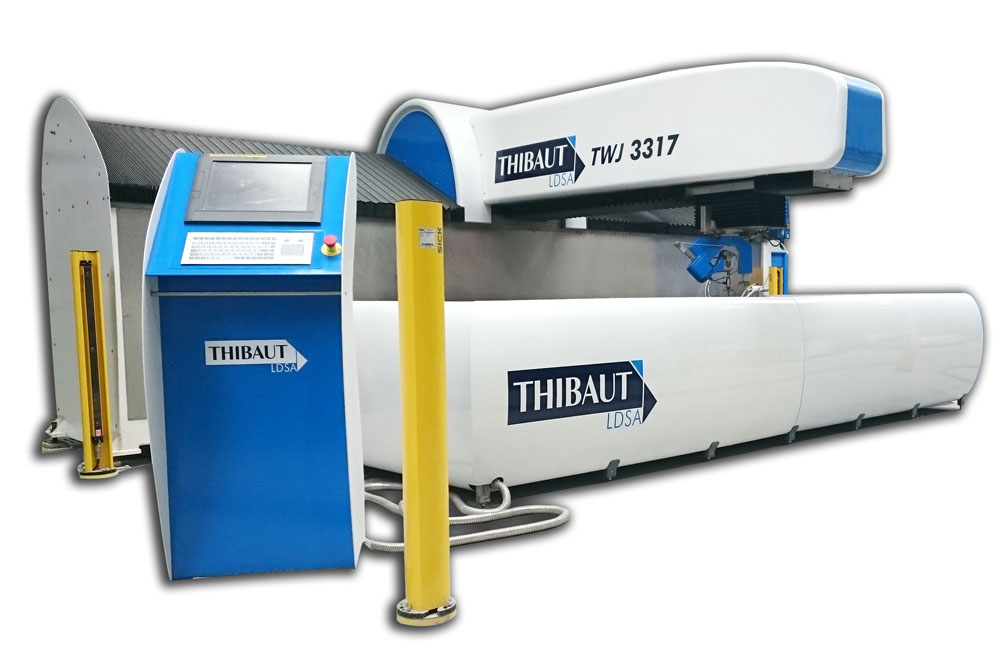
A Water jet cutter is an industrial tool (stone cutting machine) able to cut lots of materials using a high-pressure jet of water mixed with an abrasive substance. Water jet cutters are also known as waterjet or water jet.
When a waterjet uses a mixture of water and abrasives, it can be called abrasive jet, if the waterjet does not use abrasives, the term of pure waterjet or water-only cutting can be used. Pure waterjet (or water-only cutting) is used for wood or rubber, because they cannot cut hard materials.
Waterjets are able to cut hard materials by pressurizing water to ultra-high pressures and creating a powerful cutting stream (up to 6000 bars). The stream moves at a velocity of up to 3 times the speed of sound. When this high-speed water is focused on a precise point, it can cut nearly everything!
Waterjet are environmental friendly because there is no smoke, dust, vapour or gases produced.
High pressure vessels and pumps have become affordable and reliable with the advent of steam. In the middle of the 19th century steam locomotives were common and the first efficient steam locomotive was in operation; by the turn of the century the reliability of high pressure had improved, as locomotive research had increased the boiler pressure sixfold, to about 1600 psi (11 MPa). However, most high-pressure pumps were operating at around 500-800 psi (3.4-5.5 MPa) at that time.
The aviation, automotive and oil industries have also shaped high-pressure systems. In the 1940s, aircraft manufacturers such as Boeing developed seals for hydraulic control systems, while automotive designers pursued similar research for hydraulic suspension systems.higher pressures in hydraulic systems in the oil industry also led to the development of seals and advanced seals to prevent leakage.
These advances in sealing technology and the development of plastics in the post-war years led to the development of the first reliable high-pressure pump. The invention of Marlex by Robert Banks and John Paul Hogan of Phillips Petroleum required the injection of a catalyst into polyethylene, and the McCartney Manufacturing Company of Baxter Springs, Kansas, began manufacturing these high-pressure pumps for the polyethylene industry in 1960.Flow Industries of Kent, Washington, laid the foundation for the economics of waterjet nozzles in 1973 with the development of the high-pressure liquid amplifier by John Olsen, which was refined in 1976, and then combined research into high-pressure pumps with research into waterjet nozzles and introduced waterjet cutting to the manufacturing world.
The development of the abrasive water jet nozzle
While waterjet cutting is possible for soft materials, the addition of an abrasive has made the waterjet a modern processing tool for all materials. This began in 1935, when the idea of adding a blasting abrasive to the water jet was developed by Elmo Smith for liquid blasting. In 1937, Leslie Tirrell of Hydroblast Corporation refined the nozzle design, resulting in a mixture of high-pressure water and wet blasting abrasive.
The first publications on modern abrasive waterjet cutting (AWJ) were published by Dr. Mohamed Hashish in the 1982 BHR process and showed for the first time that water jets with relatively small amounts of abrasives are capable of cutting hard materials such as steel and concrete. The March 1984 issue of Mechanical Engineering showed more details and materials cut with AWJ, such as titanium, aluminum, glass and stone. Hashish, who also invented the new term Abrasive Waterjet (AWJ), and his team developed and improved AWJ technology and equipment for many applications that are now used in over 50 industries worldwide. The most critical development was the development of a durable mixing tube that withstands the force of the high pressure AWJ, and it was Boride Products (now Kennametal) that developed the ROCTEC range of ceramic carbide composite pipes that significantly increased the service life of the AWJ nozzle.Ongoing work on AWJ nozzles focuses on the microabrasive water jet, making it possible to market cutting with nozzles less than 0.38 mm (0.015 inches) in diameter.
Working with Ingersoll-Rand Waterjet Systems, Michael Dixon created the first practical means of cutting titanium sheet – an abrasive waterjet system very similar to those widely used today. 24 hours a day in January 1985, the plant produced titanium parts for the B-1B, mainly at Rockwell’s plant in Newark, Ohio, North America.
As waterjet cutting was installed in traditional manufacturing workshops, it was essential to control the cutter reliably and accurately. The first waterjet cutting systems adapted traditional systems such as mechanical pantographs and CNC systems based on the 1952 John Parsons NC milling machine and the G-code currently in operation. John Olsen of OMAX Corporation developing systems to accurately position the water jet nozzle while accurately specifying the speed at each point of the stroke, also using common PCs as controllers. The largest manufacturer of waterjet cutting systems, Flow International (a subsidiary of Flow Industries), has recognized the advantages of this system and has licensed the OMAX software, with the result that the vast majority of waterjet cutting machines in the world are easy to use, fast and accurate.
Associated vocabulary : Granite, Versatility, Affected, Drilling, Cutting tool, Processes, Capabilities, Robotic, Z axis, Machined, Water cutting, Wide variety, Gantry, Intricate, Water jet cutting machine, Pure water, The cut, A jet, Heads, Ceramics, Repeatability, Waterjet machine, Intensifier, Waterjet cutting machine, Laser, The jet, Machine tool, Tooling, Taper, Wide range, Nesting, Plasma cutting, Garnet, Fabrication, Orifice, Tolerances, Virtually, Metal cutting, Shapes, Laser cutting, Heat affected zone, The material, Aerospace, Thickness, Plasma, Accuracy, Cuts, Kerf, Precision, Water jet cutting
The Thibaut waterjets are designed to cut stone.

